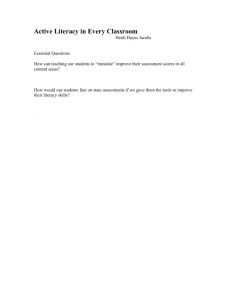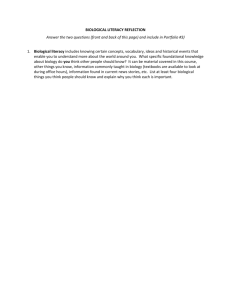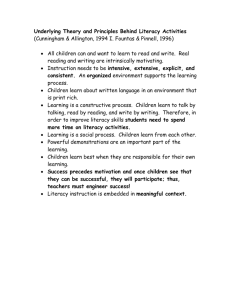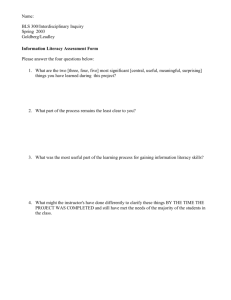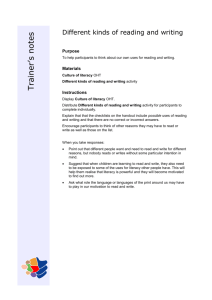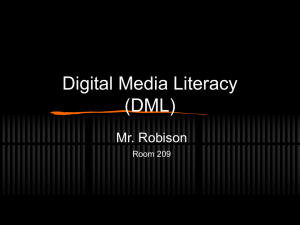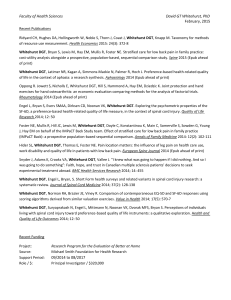The Role of Parent-Child Verbal Interaction in Language and Literacy
advertisement
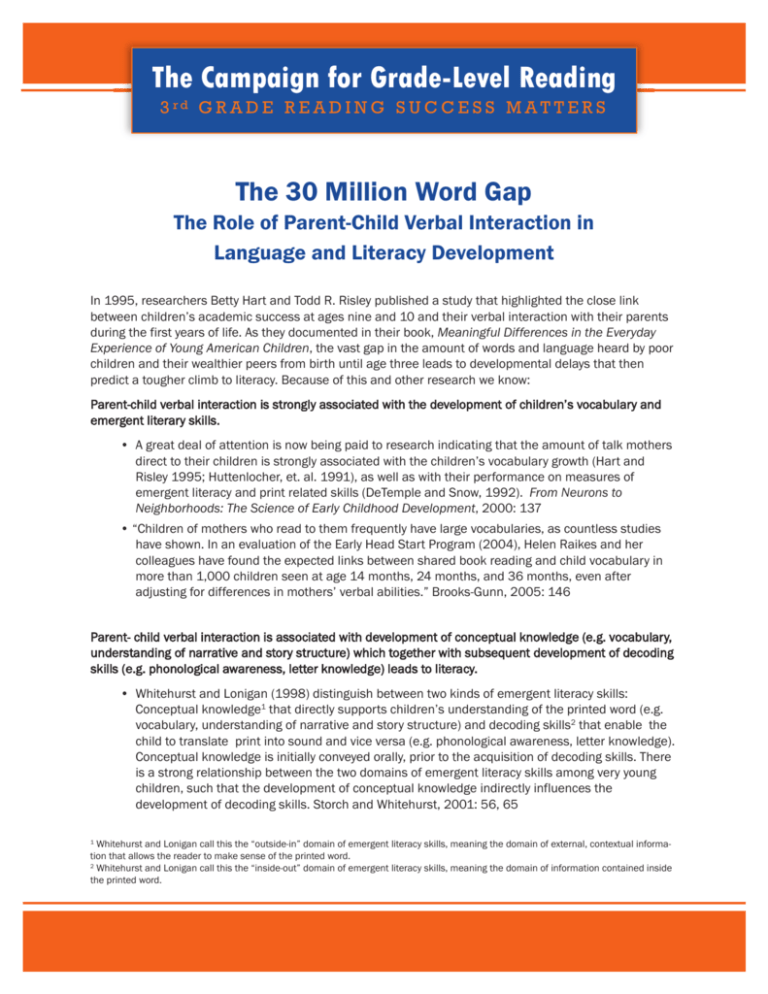
The Campaign for Grade-Level Reading 3 rd G R A D E R E A D I N G S U C C E S S M A T T E R S The 30 Million Word Gap The Role of Parent-Child Verbal Interaction in Language and Literacy Development In 1995, researchers Betty Hart and Todd R. Risley published a study that highlighted the close link between children’s academic success at ages nine and 10 and their verbal interaction with their parents during the first years of life. As they documented in their book, Meaningful Differences in the Everyday Experience of Young American Children, the vast gap in the amount of words and language heard by poor children and their wealthier peers from birth until age three leads to developmental delays that then predict a tougher climb to literacy. Because of this and other research we know: Parent-child verbal interaction is strongly associated with the development of children’s vocabulary and emergent literary skills. • A great deal of attention is now being paid to research indicating that the amount of talk mothers direct to their children is strongly associated with the children’s vocabulary growth (Hart and Risley 1995; Huttenlocher, et. al. 1991), as well as with their performance on measures of emergent literacy and print related skills (DeTemple and Snow, 1992). From Neurons to Neighborhoods: The Science of Early Childhood Development, 2000: 137 • “Children of mothers who read to them frequently have large vocabularies, as countless studies have shown. In an evaluation of the Early Head Start Program (2004), Helen Raikes and her colleagues have found the expected links between shared book reading and child vocabulary in more than 1,000 children seen at age 14 months, 24 months, and 36 months, even after adjusting for differences in mothers’ verbal abilities.” Brooks-Gunn, 2005: 146 Parent- child verbal interaction is associated with development of conceptual knowledge (e.g. vocabulary, understanding of narrative and story structure) which together with subsequent development of decoding skills (e.g. phonological awareness, letter knowledge) leads to literacy. • Whitehurst and Lonigan (1998) distinguish between two kinds of emergent literacy skills: Conceptual knowledge1 that directly supports children’s understanding of the printed word (e.g. vocabulary, understanding of narrative and story structure) and decoding skills2 that enable the child to translate print into sound and vice versa (e.g. phonological awareness, letter knowledge). Conceptual knowledge is initially conveyed orally, prior to the acquisition of decoding skills. There is a strong relationship between the two domains of emergent literacy skills among very young children, such that the development of conceptual knowledge indirectly influences the development of decoding skills. Storch and Whitehurst, 2001: 56, 65 1 Whitehurst and Lonigan call this the “outside-in” domain of emergent literacy skills, meaning the domain of external, contextual information that allows the reader to make sense of the printed word. 2 Whitehurst and Lonigan call this the “inside-out” domain of emergent literacy skills, meaning the domain of information contained inside the printed word. • The ways in which parents and children interact at home shape early differences in literacy development. Parents can tailor their child’s vocabulary development and critical thinking skills to prepare them for school by engaging in frequent conversations in academic English. As children mature, parents may increasingly use complex sentences, narrative structures and diverse vocabulary (Huttenlocher, et. al. 1991, Hoff-Ginsberg 1991, Hart & Risley 1992, Haden 1997, Weizman & Snow 2001; Goldberg 1989; Azevedo, et. al. 2007). Children who experience this kind of instruction at home have larger vocabularies and greater syntactic and narrative skills than do children whose parents do not enact such instruction. Differences in children’s oral language skills emerge as crucial once children have mastered basic decoding and the focus shifts to reading comprehension around the 2nd and 3rd grades. (Raudenbush Proposal 2010) Researchers link the achievement gap between high and low SES children to differences in quality and quantity of verbal interaction in high and low SES families. • We know that variations in parenting are associated with social, economic and educational backgrounds. The link between parental talking and child vocabulary is one example. Parents who talk a lot to their children, ask questions, use many different words and discuss events are also more likely to be highly educated—but studies that measure parental education find that that link exists independent of parental education. Brooks-Gunn 2005, 143-144 • Mother’s provision of verbal stimulation differs by education and occupation. . . higher SES mothers, compared with lower SES mothers “talk more, provide more object labels, sustain conversational topics longer, respond more contingently to their children’s speech and elicit more talk from their children” (Hoff-Ginsberg and Tardif 1995). From Neurons to Neighborhoods, 2000: 294 • Adams (1990, p. 85) estimated that a typical middle-class child enters 1st grade with 1,000 to 1,700 hours of one-on-one picture book reading, compared with an average of just 25 hours for a child from a low-income family. Storch and Whitehurst, 2001 • Children whose early language experiences do not include academic English—including complex syntax, a diverse vocabulary, and narrative skills—face a cultural mismatch when they enter kindergarten and in ensuing grades (Devillers; Craig; Labov; Casden 2001; Boggs; Au; Heath). This situation can only be ameliorated if early educators emphasize oral proficiency in academic English and thereby prepare children for the transition to reading unfamiliar text with high levels of comprehension. (Raudenbush Proposal 2010) Verbal interaction between parent and child is part of a constellation of income-associated home characteristics and family practices that influence reading readiness. • Features of the home learning environment (parents’ interactions with their young children, their beliefs about learning and their children’s capabilities, family organization) account for sizeable differences in the learning opportunities that children are exposed to prior to school entry and, in turn, for the wide disparities in knowledge and abilities that characterize kindergartners (Duncan et. al.) From Neurons to Neighborhoods, 2000: 155 • Recent work has suggested that the home learning environment might be particularly important for understanding children’s cognitive development. Several studies have found that the more positive home learning environments of high income versus low income children account for as much as half of the gap in test scores of preschool children (Smith et al 1997). From Neurons to Neighborhoods, 2000: 294 • The home literacy environment (defined as frequency and duration of shared reading, access to books at home or library visits, independent examination of books) plays out its influence early in a child’s development. Literacy environment, together with parental expectations of their children’s school success and parental characteristics (IQ, education, reading behaviors) accounts for 40 percent of the variance in preschool children’s conceptual knowledge (based on a study of 367 4-year-olds in selected Suffolk County Head Start centers tracked through 2nd grade). Storch and Whitehurst, 2001: 64 Brooks-Gunn, Jeanne and Lisa Markman “The Contribution of Parenting to Ethnic and Racial Gaps in School Readiness.” Future of Children Vol. 15, Number 1, 2005. Raudenbush, Stephen “Getting on Track Early for School Success: An Assessment System to Support Effective Instruction.” Proposal to the Annie E. Casey Foundation, May 2010. Shonkoff, Jack and Debra Phillips, Eds. From Neurons to Neighborhoods. National Academies Press 2000. Storch, Stacey A. and Grover Whitehurst. “The Role of Family and Home in the Literacy Development of Children from Low-Income Backgrounds.” New Directions for Child and Adolescent Development No. 92, Summer 2001.
